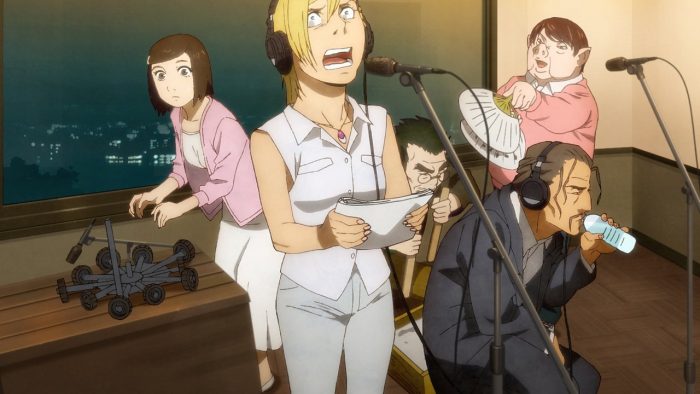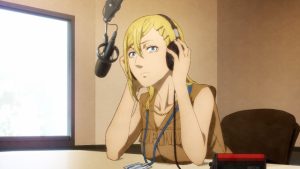
- Episodes : 12
- Genre : Comedy, Drama, Romance, Seinen
- Airing Date : April 4, 2020 – June 20, 2020
- Studio : Sunrise
Contains Spoilers

Story
For 12 episodes, the story has a very standard flow to it. It has a huge cast of characters and every character has a role to play no matter how little their screen time may be. The story does a rather excellent job of presenting the radio industry to a younger audience who are most accustomed to modern forms of technology such as listening to podcasts. Heck, even today, we can use our smartphones to pick up the radio, and Nami Yo, Kiitekure! does an excellent job of presenting that very quality.
In addition, Nami Yo, Kiitekure! also shows the audience how Minare’s 3AM program is structured to educate viewers how such a program may operate in real life. While today’s technology allows artists to have more freedom to express their creativity, the series just demonstrates that we can still learn from the professionalism and experience of older generations. Lastly, some of you may have never heard the name Minare before. Without going into spoilers, later episodes will explain the meaning behind her name and should be educational for those studying the Japanese language.
Character and Relationship Development
Being only 12 episodes, the anime does end with a relative amount of development, but we don’t get to see where that development takes the characters. By the end of the series, Minare knows she still has a long way to go before she can become a true pro. Plus, it’d be nice to see what kind of suggestions she takes. Makie, who works at the curry restaurant throughout the third act, is developed in a minimal sense and we feel that, with a longer series, so much more could’ve been done with her.
While the character development individually feels “complete” for 12 episodes, the relationship development needed a bit more work. We feel that Minare’s relationship with Chuuya, her co-worker, needed a lot more work. While the series suggests there could be a love triangle between Minare, Maki, and Chuuya, very little is explored with it.
Art and Animation
For those that are familiar with the works of Hiroaki Samura (most famous for Blade of the Immortal), he takes a more realistic approach. None of the hairstyles are exaggerated like in Dragon Ball, and if anyone has unnatural hair color (at least as it applies to the Japanese race), then we can reasonably assume it’s dyed. With how anime colors and shades, the style of Samura doesn’t fully transition 100%, but with how Sapporo (especially parts of Susukino district are shown in the intro) is shown, you feel as if you’re actually there.
What Nami Yo, Kiitekure! does best is expressing the body language and facial expressions of Minare. She stands tall, she’s very emotional, and she has a unique presence. If there’s anything that Nami Yo, Kiitekure does best, it’s expressing the presence of every character. With Makie, you can see that she’s meek and hesitant, while with Chuuya, you can tell he tries to look tough, but he’s very sensitive. Samura’s specialty is physical expression after all, and the anime adaptation does its own distinguishing job of respecting that quality.
Voice Acting
What we love best about Nami Yo, Kiitekure! is the bombastic performance of Riho Sugiyama, the voice of Minare herself. You may know her as the voice of Nyuu from Ishuzoku Reviewers, and Anita from the 5th installment of JoJo. As a matter of fact, she happens to be a Hokkaido native herself, so it was only natural she would get the role. She perfectly balances Minare’s qualities of being blunt and yet vulnerable. Through Shinshuu Fuji, the voice of Matou, you feel his experience, wisdom, and yet, has a gambler’s edge to him. With Masaaki Yano as Chuuya, you do feel his presence as the comic relief, but he also knows how to capture his serious qualities.
Music
A majority of the soundtrack is very upbeat and knows how to set the mood. The opening song perfectly captures the themes of following your dreams and being true to yourself. The ending piece, while much softer and not as bombastic as the opening, pretty much captures the message of following one’s dreams. The background music isn’t very memorable, but it gets the job done of capturing either a dramatic, comedic, or romantic scene.
Final Thoughts

Considering that the manga is only six volumes, we understand that the anime has to be short. It lays the groundwork for who the characters are and where the story takes place. Nami Yo, Kiitekure! introduces a lot of qualities, but does very little to run with them, for reasons we have just shared. Compared to Hiroaki Samura’s previous works like Blade of the Immortal, audiences can see that he can do more than tell samurai tales. Through Nami Yo, Kiitekure!, we get to see what he can do with a modern setting, but with an older twist to them. We see the potential that this series truly has with where it can go and we hope that it can continue in the future so we can see where everyone’s journey goes. In the end, there’s always the manga. So, what do you readers say? Have any of you read the manga to give any thoughts on how the series should proceed? If so, please leave a comment!




